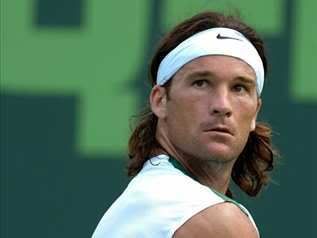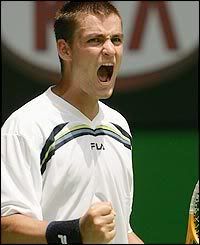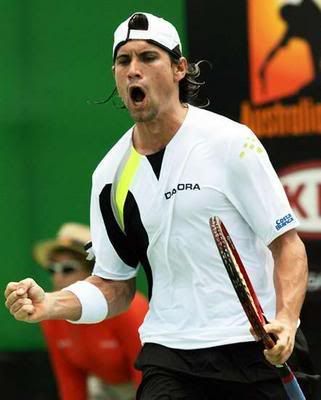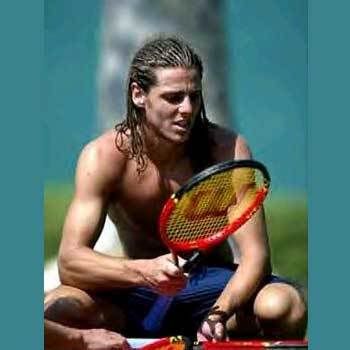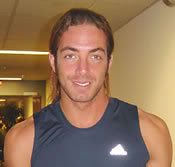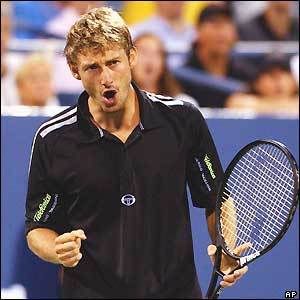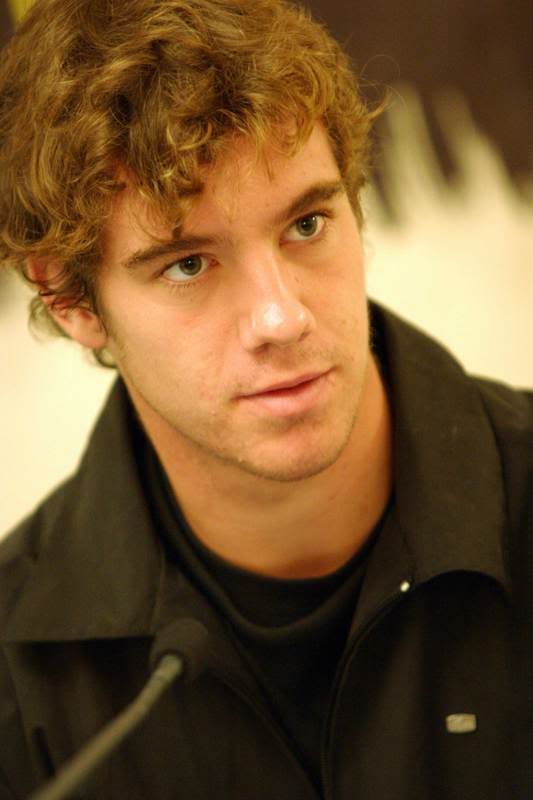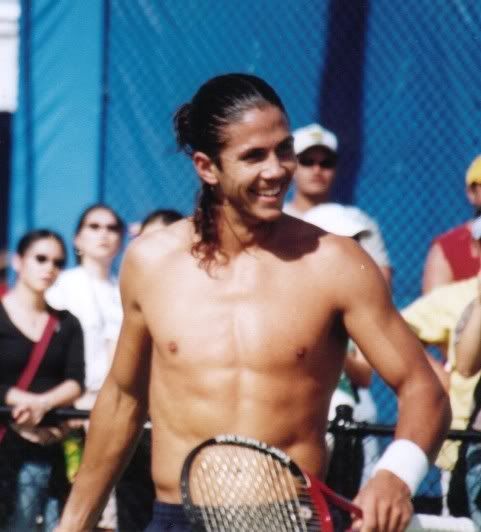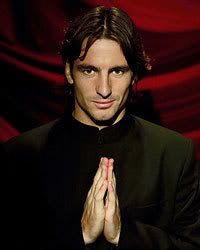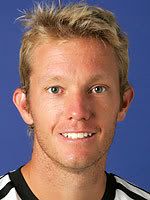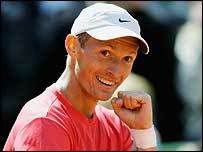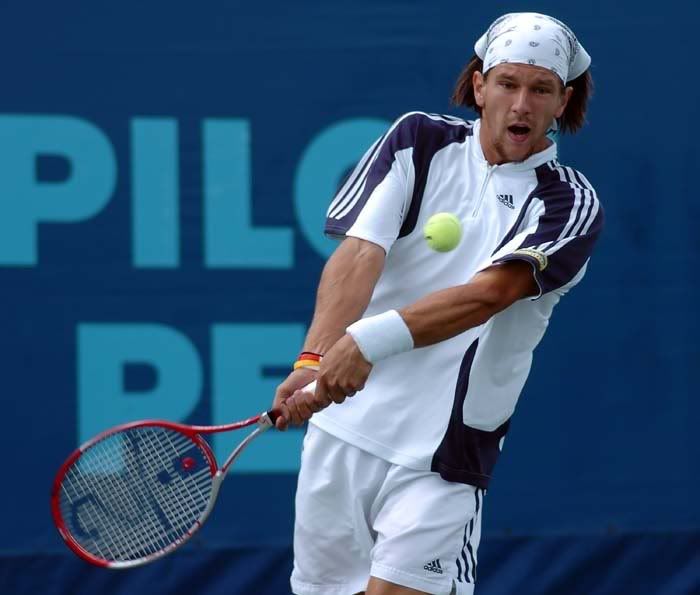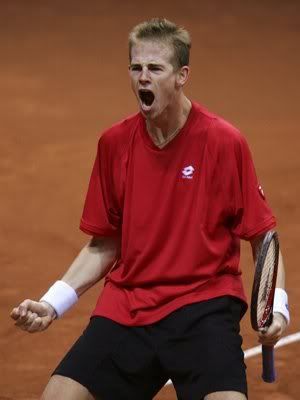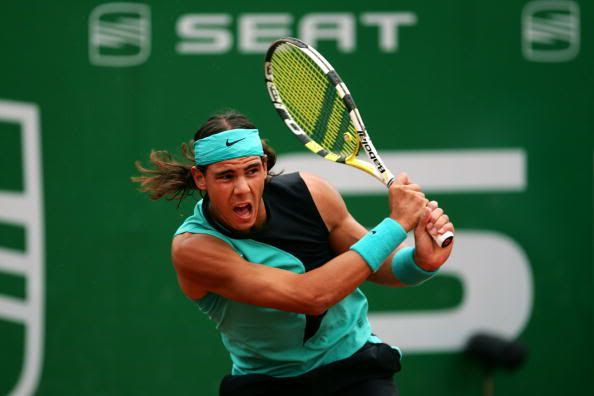
Champion Open SEAT Godo 2007
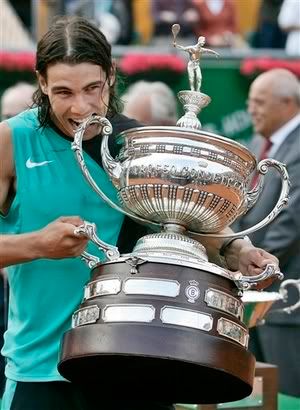
A blog about tennis.
For some odd reason, there's a misconception out there it's the players who have the most say on major tour issues. They don't and haven't had a significant impact in quite some time...
But let's be really serious here about who hired de Villiers in the first place: the tournament directors, who received, in my not some humble opinion, a rubber stamp for the players. You didn't think that Roger Federer, Rafael Nadal and Ivan Ljubicic had time to conduct extensive job interviews, did you?
That doesn't mean that de Villiers is completely beholden to the TDs, but when he takes a look at the other six members of the ATP Board of Directors, he knows who is cutting his paychecks and where the power lies. Currently, it lies with the TDs and the major sports agencies.
de Villiers has one vote, as do tournament reps Charlie Pasarell (the Indian Wells owner who is certainly one of the most powerful men in the sport), Auckland Tennis CEO Graham Pearce and Monte Carlo TD Zeljko Franulovic (back to him later). The players selected super agent Perry Rogers (Andre Agassi's agent), Jacco Eltingh and Iggy Jovanovic. I'll give the players two strong votes in former doubles standout Eltingh and Iggy, who used to be a communications official. But that's it. Rogers understand the players concerns, but he's a business guy first and is likely looking at profit as the primary motive. Plus, he's American and sees more potential in keeping four strong Masters Series in North America (Indian Wells, Miami, Cincy and Canada), than he does in saving Hamburg's or Monte Carlo's TMS status (although maybe Steffi Graf is trying to convince him otherwise.)
I'm not sure how the vote broke down when the board voted on de Villiers recommendation for the 2009 calendar – which was to downgraded Monte Carlo and Hamburg, add Shanghai and move Madrid to the spring – but my guess is that Franulovic balked in a big way and stormed out, de Villiers and the two other tournament directors said fine, and so did Rogers. That's' enough votes, folks, regardless of what Roger Federer, Rafael Nadal and ATP Player Council president Ivan Ljubicic asked their player reps to do.
Look, if the players want to make the ATP a "player organization," then they have to get the tiebreaking vote on board of directors. I don't believe that they've ever had that on a consistent basis from their CEO, so they are sitting clay pigeons when it comes to major issues like the calendar, unless they force their CEO to the wall, which they have done this week.
Now, when they have embarrassed De Villers publicly with players like Ljubicic saying "ET doesn't understand tennis," they bring out a big stick by essentially saying that we are not buying into your calendar and you can take your mandated tournaments and shove them into your racket bag.
That's the power that they do have … which is not show up where they don't want to play.
Just imagine how happy Shanghai is going to be if most of the top competitors don't go. Guess who's going to get an earful and a request for a major refund - de Villiers.
According to the Daily Telegraph's excellent Mark Hodgkinson, de Villiers told Federer, Ljubicic et al that's he's willing to be flexible and maybe, just maybe, they will reconsider letting Monte Carlo keeps its status. But Hamburg still appears to be in real trouble.



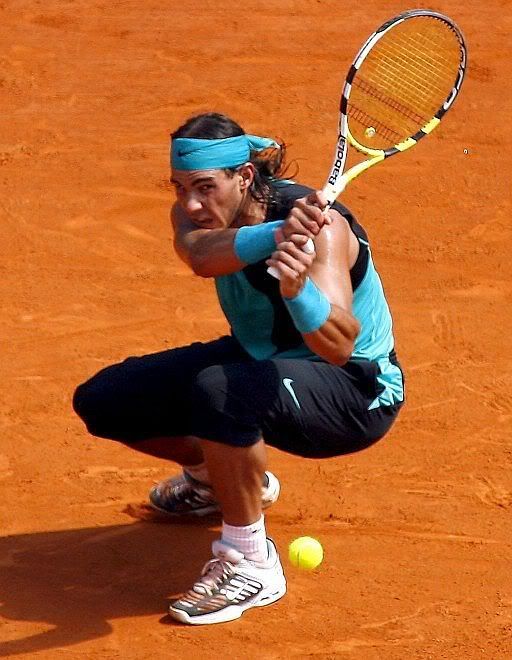
...as I was basking in the glow of his(Rafa's) victory, I read a bit of an article that said, in layman's terms: In order for Rafael Nadal to prove he is no one trick pony he has to win on other surfaces. Which is true. He has had some results on other surfaces, most notable, his reaching the Final in the 2006 Wimbledon Championship. But then I started to think. Really think. Should people only be picking on Nadal? Yes, I am a Nadal fan but seriously. Everyone has a speciality. Federer and Sampras had/have Grass, Roddick has Hard Courts, and Nadal has clay. So why is it when Nadal has proven he is best at one surface, suddenly the rules are changed he has to win other surfaces?


 The second point of the secong game of the second set brought the entire crowd to its feet. A protracted rally ended in Federer's favor when Nadal tried to between-the-leg an excellent lob Roger touched over Rafa's head. Roger won the point. Rafa, the game.
The second point of the secong game of the second set brought the entire crowd to its feet. A protracted rally ended in Federer's favor when Nadal tried to between-the-leg an excellent lob Roger touched over Rafa's head. Roger won the point. Rafa, the game.










 (1)Roger Federer (SUI) vs. (16)Juan Carlos Ferrero (ESP)
(1)Roger Federer (SUI) vs. (16)Juan Carlos Ferrero (ESP) (2)Rafael Nadal (ESP) vs. (10)Tomas Berdych (CZE)
(2)Rafael Nadal (ESP) vs. (10)Tomas Berdych (CZE)As a kid, I would watch McEnroe play Borg, then head out, wooden Dunlop Maxply in hand, and stand in front of a school wall volleying like Johnny Mac. The goal was to hit the ball as many times as possible without letting it hit the ground.
But McEnroe was not the prototype. Jean Borotra (“the Bounding Basque”) was the first truly world-famous serve-and-volleyer, one of France’s “Four Musketeers,” who dominated tennis in the late twenties and early thirties. Borotra started playing while serving in the French army and developed a style in which, according to tennis histor-ian Arthur Voss, “he sought [the net] at every opportunity.”
Borotra was followed by Pancho Gonzalez, who grew up playing on the concrete courts of South Central Los Angeles and was never embraced by the wasp tennis establishment. A loner with an explosive temper who only grew more effective when angry, Gonzalez played a serve-and-volley game so devastating that tournament organizers briefly changed the rules in order to prevent him from coming to the net immediately after serving.
Legendary Australian player Rod “the Rocket” Laver, though skilled from the backcourt, came in incessantly and won all four of the major singles titles (Wimbledon and the Australian, French, and US Opens) twice each, becoming the only double Grand Slammer in the history of the game. Laver’s style inspired the generation of great serve-and-volley players led by McEnroe, Edberg, and Boris Becker.
Starting in the midseventies, however, technological advances and the popularization of tennis set the stage for the demise of the serve-and-volley ethos.

 (1) Roger Federer vs. (12) David Ferrer (ESP)
(1) Roger Federer vs. (12) David Ferrer (ESP) (16) Juan Carlos Ferrero (ESP) vs. (11) Richard Gasquet (FRA)
(16) Juan Carlos Ferrero (ESP) vs. (11) Richard Gasquet (FRA) (10) Tomas Berdych (CZE) vs. Robin Soderling (SWE)
(10) Tomas Berdych (CZE) vs. Robin Soderling (SWE) (2) Rafael Nadal (ESP) vs. (Q) Philipp Kohlschreiber (GER)
(2) Rafael Nadal (ESP) vs. (Q) Philipp Kohlschreiber (GER)the right-hander from Duluth, Ga., has a game style that few juniors see on a regular basis, and his commitment to serve-and-volley disrupted the quick and consistent Californian.
Carleton also possesses one of the most fluid one-handed backhands in the junior ranks, and Damico, who is temporarily using one due to a wrist injury, knew that his wasn’t of that caliber. In fact, after Damico made a backhand error, he loudly commented in Carleton’s direction: "Maybe after the match you can teach me how to hit a one-hander," Damico said.


Q. Sounds like you're not playing Monte-Carlo. How does that happen?
JAMES BLAKE: Well, for me it's something that doesn't quite fit into the schedule. It's going to be real tough to go from Houston all the way over to Monte-Carlo, then come back just for a week or two to train for Rome.
For the Americans, that tournament has never been exactly the easiest one in the schedule. I'm not going to be able to make it to that one.
Q. Any sanctions for not doing that, because it's a mandatory event?
JAMES BLAKE: Well, I think I'll get a zero pointer. I'll lose my chance to get points there. I believe there's a way that you're allowed to miss one and not get fined. This will be the one I miss.
 Throughout the years, men who executed their aggressive games were still able to win Roland Garrros. Yannick Noah and Tony Roche immediately spring to mind. Ivan Lendl, Andre Agassi, and Jim Courier were aggressive baseliners. At the top of his game, you might even call Juan Carlos Ferrero an aggressive baseliner.
Throughout the years, men who executed their aggressive games were still able to win Roland Garrros. Yannick Noah and Tony Roche immediately spring to mind. Ivan Lendl, Andre Agassi, and Jim Courier were aggressive baseliners. At the top of his game, you might even call Juan Carlos Ferrero an aggressive baseliner. Look at the list of women players who've won Roland Garros over the last two decades. Why have women with aggressive games had better success on clay than men? Why is the greatest claycourt player the game has ever seen a woman -- a flat striker of the ball, no less -- from southern California? Another discussion indeed.
Look at the list of women players who've won Roland Garros over the last two decades. Why have women with aggressive games had better success on clay than men? Why is the greatest claycourt player the game has ever seen a woman -- a flat striker of the ball, no less -- from southern California? Another discussion indeed.You're absolutely divine on your soapbox, but I'd like to dispel a few myths, if I may.
Under Tariq, Roddick won 3 claycourt titles (Atlanta, Houston, St. Poelton), made the semifinals of Rome, the third round of RG where he retired to Hewitt after twisting an ankle, and also lost in the first round the same year he won St. Poelten (2003. Incidentaly Federer lost first round that year as well). The press hounded Roddick to change coaches. He did. He also never won a Davis Cup match away on clay under Tariq.Since Tariq, Roddick has won two claycourt titles (Houston, 2x), made the quarterfinals of Rome, choked away two winnable second round matches at Roland Garros up two sets to one (Mutis - 2004) and two seets to love (Acasuso - 2005), and lost in the first round through retirement last year. He's also won four crucial Davis Cup matches away on clay.
In short, Roddick's record on clay post Tariq is only nominally worse, considering that he won exactly the same number of Roland Garros matches, finished a round earlier at Rome, qne one less title, but won 4 more Davis Cup matches.
Does "Roddick won on clay before dropping Tariq as his coach. He's been miserable on it since," still sound reasonable?
I don't generally defend Blake, BUT... before losing to Monfils and Zabaleta, he defeated Almagro (ESP) and Juan Monaco (ARG), respectively, neither of whom is any pushover on clay. It's also safe to say that his impatience against Zabaleta had to do with 1) his grueling 3 setter against Monaco the night before and 2) his recent Davis Cup efforts. His choke to Monfils was exactly that. I remember you saying he had that match and let it slip away. But that's Blake more than the surface.
If I recall, Blake choked to Ancic in the 16s or the quarterfinals of Hamburg last year, something he can do on the big stage on ANY surface.
Andre Agassi never backed off the baseline on clay, never slid, never imparted too much topspin on his shots. He didn't overadjust his game to the surface and didn't appear to have any mentally allergies to the surface. He won Rome once, Roland Garros once, and made another (two?) finals in Paris. He didn't grow up on clay.
Michael Chang won Roland Garros and never another Slam. Is clay supposed to be the supreme measure of a tennis player? Just because it tests your patience and your endurance but, by and large, penalizes your shotmaking? Just curiuos.
Tony Roche and Yannick Noah, to list just two, won Roland Garros by serve and volleying and chipping and charging. On a slower surface with wooden rackets. The points were short. Tony Roche didn't grow up on clay.
Martin Verkerk serve and volleyed and chipped and charged his way to a Roland Garros final on a medium slow surface with a high-tech racket, defeating at least one defending champion along the way. The points on his serve were short.
I'm not exactly sure what Justin Gimelstob is talking about. But it sounds familiar, that's for sure.
Roddick's biggest problems on clay are mental. See his results against Tommy Haas, a player he's never beaten on clay (but handled on other surfaces) and yet Ivo Karlovic, a player with a similar game and less athleticism, can defeat Haas on clay in straight sets the first time he plays him. Matchups. I know. Which support the same claim since matchups are more mental than anything else.
Every year we hear the same old story about American men on clay, even before the season is in full force. Isn't it entirely possible that the players' mental allergies to clay are simply reinforced by this barrage of redundancy?
Wouldn't it be interesting if, for instance, an American journalist pointed out the improvement of American men on clay as their Davis Cup results and their collective TMS results on clay over the past two years have indicated? Even Mardy Fish won a claycourt title.
Wouldn't it be as revealing to compare Roddick's 5 claycourt titles to David Nalbandian's ZERO? Roddick's career claycourt record to [insert name of any second-tier claycourter from South America or Europe here]?
And speaking of Roddick and coaches, Jimmy Connors knew his way around the slow stuff with his flat strokes and big old heart.
I hope Roddick's hamstring heals well enough so that he can be competitive in the claycourt events he does contest. He's got Rome quarterfinal points to defend, afterall. Lord knows he played Verdasco like he was on a claycourt, drifting 20 feet behind the baseline to absorb Verdasco's topspin and pace, and he still won the match in straight sets. On a fast indoor hardcourt. With a sore hamstring.
I've seen Roddick (and Blake) construct points on clay. Roddick, in particular, falls short because he doesn't expect anything of himself, doesn't believe in himself. Is he ever going to win Roland Garros? Only if a series of miracles occur. But I think he'd do a whole lot better there than he has if the talkers, whom he listens to and takes seriously, don't doom him before he even sets foot on Philippe Chartrier.
Our words have power. Perhaps, if we want to see more success from our men, we try pumpimg them up instead of cutting them down.
Oops. I think I stand corrected. I believe Nalbandian has won a claycourt title. One for sure. No more than two, I don't believe.
American players are raised to focus on building weapons and finding ways to attack and win points. Clay-court tennis puts a premium on defense and manipulating your opponent into low-percentage positions where he will eventually lose the point.
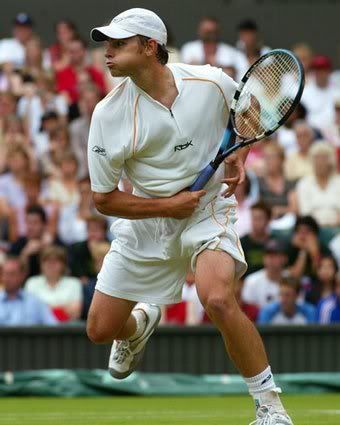
American players are raised to focus on building weapons and finding ways to attack and win points. Clay-court tennis puts a premium on defense and manipulating your opponent into low-percentage positions where he will eventually lose the point.
South Americans and Europeans who grew up on clay have such an overwhelming advantage because of years of practice combining the movement and the patience of developing a point that we Americans can't learn in a crash course.

